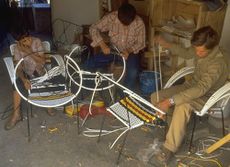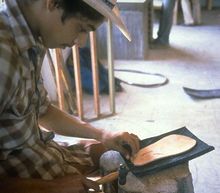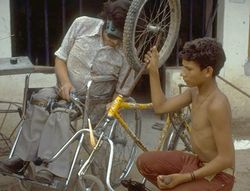Hesperian Health Guides
Financing
HealthWiki > Disabled Village Children > Chapter 50: Organization, Management, and Financing of a Village Rehabilitation Program > Financing
Contents
The myth of self-sufficiency
It is a goal of many community programs to become as financially self-sufficient as possible. Only when a program does not depend on outside funding, can the community and participants of the program have a full sense that "The program is ours. We run it. We control it. We make the main decisions ourselves."
Realistically, however, for health programs in general and for rehabilitation programs in particular, economic self-sufficiency is difficult to accomplish. This is especially true if the program aims to serve mainly those who are poorest and whose needs are greatest. The poor earn barely enough to feed and clothe their children, and then sometimes not adequately. The additional expenses of trying to meet the needs of a child with disabilities may be too much for the poor family to bear, even when the costs are kept low.
The biggest obstacle to economic self-sufficiency of any community program is poverty.
In a country where social injustice causes widespread poverty, it is not fair to expect the poor to pay for more than a small part of the cost of rehabilitation services or aids. Nor is it fair to ask a busy rehabilitation team to try to make their program self-sufficient through separate “income-producing activities.” (However, income-producing activities can help meet some expenses and prepare people with disabilities to work and earn independently. (We discuss this below.)
True self-sufficiency of a community service program may only be possible through a process of social change and fairer distribution within the whole structure of the society. Only when enough jobs are available and nearly every family earns enough to be self-sufficient in terms of meeting its basic needs, can program self-sufficiency become a realistic goal. In the meantime, some sort of outside funding, government or private, is usually necessary.
Funding — government or non-government?
Ideally, governments should help meet the costs of people-centered community-run service programs. Unfortunately, government funding often brings with it a high degree of outside control, including pre-defined (often disabling) limitations regarding local planning and how much community workers are taught or permitted to do. People with disabilities and their families tend to become the objects of program objectives, to be worked upon, rather than the leaders in their own struggle for dignity and self-reliance.
Also, it is usually difficult for a local village or community group to ask for and obtain funding from the government. The red tape, preliminary investigations, restrictions, and delays are often endless. More promises are made than are kept. Thus to speak of a government-financed community-oriented program usually makes little sense.
One exception to this is the ODR (Organization of Disabled Revolutionaries) in Nicaragua, a non-government, people-centered program for which the Sandinista government had set up a red-tape-free “auxiliary fund” to helpfamilies pay for aids and services (see Local funding). Such restriction-free aid may only be possible in countries where popular governments have a strong political will to serve the people fairly.
NON-GOVERNMENT FUNDING
This can come from a variety of sources, including volunteer agencies, charitable foundations, and religious charities. To permit greater independence, it is a good idea to have several sources of funding. (Some government assistance may possibly be included without sacrificing community control, if the amount is relatively small.) In Pakistan, a religious (Islamic) law each year takes two and a half percent of the money people have in banks, to be used by local committees for the benefit of widows, orphans, and people with disabilities. Since this law was passed in 1981, it has become a growing source of support for community rehabilitation centers.
LOCAL FUNDING
It is also a good idea that a fair part of program costs—if possible at least half—be met within the community. Possible local sources for meeting costs include:
 |
| Nobody knows how much the individual family gives. |
 |
| Weaving of chairs with plastic ribbon on a metal frame brings in income and provides skills training. (PROJIMO) |
 |
| Sandal making produces income and teaches a skill for later self-employment. (PROJIMO) |
- Fees or contributions from families served: Some families will be able to pay more than others. Therefore, the fee should depend on their ability to pay. When families come from outside the community, their ability to pay may be hard to judge. Project PROJIMO has tried an honor system for payment of services. They ask the family to make whatever donation they can afford. So as not to shame the family who gives little, or make proud the family who gives more, each family puts whatever they can in a closed box in the corner. Only the family knows how much they gave.
- Service “in kind” or with work: The community's contribution does not have to be in money. People can donate materials (sand and rock for building), do volunteer work, or provide food and lodging. All this reduces program costs.
- Income-producing activities: Production of things for sale is another way to help meet program costs. It also provides skills training for older children and temporary workers in the program. We will discuss this further on "Learning Skills for an Active or Productive Role in the Community".
Although production of items for sale may not bring in much money, the extra income may mean that more people with disabilities can be employed on the program staff. They can learn rehabilitation skills and at the same time learn income-producing skills, both of which they may put to good use then they return to their own village.
Some programs that are run for and by people with disabilities have succeeded in meeting a large part of their costs through production and sale of goods. For example, the Centre for the Rehabilitation of the Paralysed in Bangladesh creates a wide range of orthopedic and hospital equipment, much of which they sell to orthopedic hospitals. The Disabled Revolutionaries of Nicaragua has succeeded in developing a nearly profitable business out of making low-cost, rough-terrain wheelchairs. In Paraguay, a group of workers with disabilities has also made wheelchair making a small but profitable business.
 |
| A PROJIMO wheelchair builder welds the broken frame of a village boy’s bicycle. |
- Repair services: In addition to producing items for sale, a team of village rehabilitation workers with disabilities can provide a wide variety of repair services. The PROJIMO team in Mexico repairs plows, welds broken machinery and tools, repairs bicycles, solders holes in buckets and car radiators, re-soles boots and sandals, and sharpens axes. (They have even repaired broken plaster saints from the church!) All these services they provide using the same skills and equipment that they use in making wheelchairs and rehabilitation aids. No one else in the village provides these skilled repair services. They have therefore done a lot to increase the villagers' respect and appreciation for people with disabilities in the community.
- An “auxiliary fund” to help poor families pay for aids and services: As we have discussed, many families cannot pay for the services or aids their child needs, even though a community program provides these at low cost. Some kind of economic assistance is needed to adequately meet the needs of a child with disabilities.
To provide such assistance, PROJIMO has arranged for an auxiliary fund provided by outside donors. The fund, which is kept in a separate bank account, pays to PROJIMO the difference between what a poor family pays and the actual cost of aids or services received. Thus the workers get full payment for the services and aids they provide. In effect, the fund aids poor families, not the program directly. This allows the team to have a better measure of its accomplishments. If the team works efficiently and gains the necessary management skills, in time the program should need no more direct outside funding. The payments from the auxiliary fund, together with whatever families are able to give, should cover the cost of wages, supplies and maintenance. This will mean that the program has in a sense become self-sufficient; even though poor families still need financial aid. Project PROJIMO began to approach self-sufficiency on these terms in its third year.
An argument can be made for trying to obtain government financing for the auxiliary fund. (This is being done in Nicaragua.) The fund could even be managed by a local official (if honest) or another administrator outside the rehabilitation program. At the end of each month, the team could give the administrator an accounting of the services and aids provided, their calculated value, and the amount paid by families, with receipts. Payment would be made, as if by contract.
Below is a form that can be used for keeping records for money to be paid by the auxiliary fund (adapted from Project PROJIMO).



